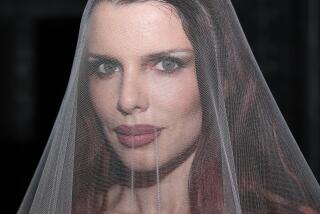Don’t Know Much About Herstory : OUR LADY OF BABYLON.<i> By John Rechy (Arcade: $23.95, 353 pp.)</i>
In the beginning of John Rechy’s new novel, “Our Lady of Babylon,” Eve tells her version of the Creation. “There was a flower that bloomed only in Eden, a flower so glorious it did not need the decoration of leaves. Its color is long gone from the world because it was exiled with me and my beloved.
“When he saw me for the first time, as I lay within the verdure of Eden, my Adam plucked a blossom from the leafless stem. He knelt and with its petals grazed my body.
“I sprang to life on a bed of orchids.”
In Rechy’s telling, Adam and Eve know they are naked and they come to know each other in the biblical meaning of the word.
At this point I was hooked. The biblical account of Adam and Eve is so sparing of detail. Rechy’s new novel puts more flesh on the bones of this ancient story--wonderfully erotic flesh.
Eve’s essence, in the course of this book, will roam through time and places, assuming the forms of Salome, the Whore of Babylon, Medea, Helen of Troy, Mary Magdalene and Jezebel. Finally this female essence arrives at its present incarnation--a nameless Lady living in an unnamed country during the 18th century, framed for killing her husband.
The “plot” unfolds mostly as a series of conversations between the Lady and mysterious Madame Bernice, an eccentric mystic. During these conversations, the Lady realizes that her situation is not unique. In her past incarnations--as Eve, Helen of Troy, Salome etc.--she was also erroneously blamed for the evil doings of men. Her goal thus becomes to make public the real story behind the myths that have maligned women for centuries. Rechy’s novel presents the Lady as a kind of alternative Christ figure whose goal is to redeem all women by rewriting and correcting history.
The Lady “corrects history” in the context of the stilted conversations with Madame Bernice to rehearse for the interviews she will give to make public the hidden truth. I continually sensed the author’s presence hovering over his characters like a puppeteer, manipulating them to fit his feminist ideas.
This is surprising because in Rechy’s first novel, “City of Night,” the hustlers, drag queens and polysexual men who prowl through their sexually outlawed world are so real they almost grab you by the throat. Mercifully, there is also an underworld in “Our Lady of Babylon,” for this is where Rechy is at his best. The novel’s subplot features erotic excerpts of a mysterious “True Account” detailing the Lady’s alleged debauchery to malign her.
The bare bones of Rechy’s story is certainly intriguing. But the novel is ultimately disappointing, suffering from the ills of much ideological art. “Our Lady of Babylon” is neither good art nor good ideology.
Although the Lady’s reinterpretations of the ancient misogynistic myths are clever, they come across like empty intellectual exercises because they are encased in Rechy’s hollow plot device. Each time the reader becomes engrossed in the retelling of one woman’s story, the Lady intervenes by abruptly switching to another’s story or by becoming overly absorbed in the precious details of the Lady’s conversation that frames all the narratives. Madame Bernice endlessly changes her rings “from one finger to another, the pearl in place of a ruby, the amethyst where a diamond had been” and frequently fusses over her pet peacock, Ermenegildo.
“[Madame] pushed her own cup away, a signal that Ermenegildo...would feast on some crumbs remaining on the silver plate. Madame would not disappoint him. She crumbled a cake, fed it to him, and touched his comb, quite subtly smoothing the feather that immediately twisted away from the others.”
For anyone seeking a fuller understanding of the novel’s ideological underpinnings, I would recommend turning to Elaine Pagels’ “Gnostic Gospels” (Random House, 1980), which documents alternative versions of the biblical myths based on a major archeological discovery of buried manuscripts at Naj Hammadi in 1945 and discusses why these versions were excluded from history.
More to Read
Sign up for our Book Club newsletter
Get the latest news, events and more from the Los Angeles Times Book Club, and help us get L.A. reading and talking.
You may occasionally receive promotional content from the Los Angeles Times.






